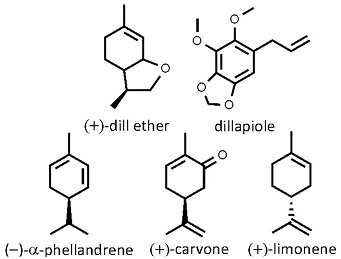 Anethum graveolens
Anethum graveolens
dill
Back to “Salad herbs and herb mixtures: dill (Anethum graveolens)”
Back to “Culinary herbs: dill, dill weed (Anethum graveolens)*”
Back to “Spices: dill (Anethum graveolens)fr”
Anethum graveolens L. (= A. sowa Roxb.) (Apiaceae); dille (Afrikaans); bazrul shibbat, shibit (Arabian); aneth (French); Dill (German); anithi, sotapa, sowa (Hindi); aneto (Italian); koper (Polish); ukrop (Russian); eneldo (Spanish); dill (Swedish)
DESCRIPTION Dill weed is the whole plant with finely divided aromatic leaves, small flowers and immature fruits (“seeds”), used fresh or dried.1 Dill fruits (“dill seeds”) are the small dry schizocarps, up to 6 mm (¼ in.) long that split into two flat, elliptic, single-seeded mericarps at maturity. They are brown with a lighter-coloured edge.
THE PLANT An erect, fennel-like annual or biennial herb, up to 1 m (ca. 3 ft) with blue-green, deeply divided (pinnately compound) leaves and small yellow flowers borne in umbels.1
ORIGIN Southwestern Asia and southern Europe, but is naturalized in many parts of Eurasia and North America. It was regarded as a symbol of vitality in Roman times.
CULTIVATION Dill is grown as an annual crop and requires cool temperatures, long days, a regular supply of water and deep, fertile, slightly acidic to neutral, loam soils. It is sensitive to extreme temperatures, drought and strong winds. Commercial production is centred in India and Pakistan.1 It is cultivated in kitchen gardens all over the world for culinary use.
HARVESTING Dill leaves are best used fresh but dried leaves (“dill weed”) are also available. Harvesting for the leaves (or for distilling the essential oil) is done just before the plants flower. Yields of about 25 tons fresh leaves per hectare can be expected (or 0.5 tons of dry fruits per hectare).1
CULINARY USES Dill herb is more aromatic than fennel. Twice as much fresh herb is used to equal the required amount of dry herb.1 The most famous applications are for the seasoning and garnishing of fish dishes, potato salad and pickled gherkins (e.g. Russian pickled cucumbers).2 The aromatic fruits are used in dill pickles, dill butter, breads, cheeses, sauces, vegetables and especially vinegars.2 Dill fruits are used as a spice in North African meat dishes and in traditional Scandinavian crayfish or salmon. The essential oil has numerous commercial uses as an ingredient of confectionery, desserts, condiments, beverages and meat seasonings (especially for sausages).
FLAVOUR COMPOUNDS The essential oil of dill weed (dill herb) has α-phellandrene and (+)-dill ether (anethofuran) as main compounds, giving it the typical dill flavour.3,4 The fruits are rich in (+)-carvone (up to 70%) and (+)-limonene (30 to 40%), with smaller amounts of α-phellandrene and dillapiole. Dill weed oils with higher levels (10 to 20%) of α-phellandrene and less than 20% carvone are therefore preferred. Fruit oil of Indian dill (a chemotype previously known as Anethum sowa) is rich in dillapiole (up to 40%).3,4

NOTES Dill or dill essential oil is used in traditional medicine for digestive ailments and infant flatulence. Long known for its carminative powers, its name is derived from the Old Norse word “dilla”, meaning to lull or soothe.
1. Farrel, K.T. 1999. Spices, condiments and seasonings. Aspen Publishers, Gaithersburg, USA.
2. Kiple, K.F., Ornelas, K.C. (Eds). 2000. The Cambridge world history of food. Cambridge University Press, Cambridge.
3. Reichert, S., Wüst, M., Beck, T., Mosandl, A. 1998. Stereoisomeric flavor compounds LXXXI: dill ether and its cis-stereoisomers: synthesis and enantioselective analysis. Journal of High Resolution Chromatography 21: 185–188.
4. Rădulescu, V., Popescu, M.L., Ilies, D.-C. 2010. Chemical composition of the volatile oil from different plant parts of Anethum graveolens L. (Umbelliferae) cultivated in Romania. Farmacia 58: 594–600.